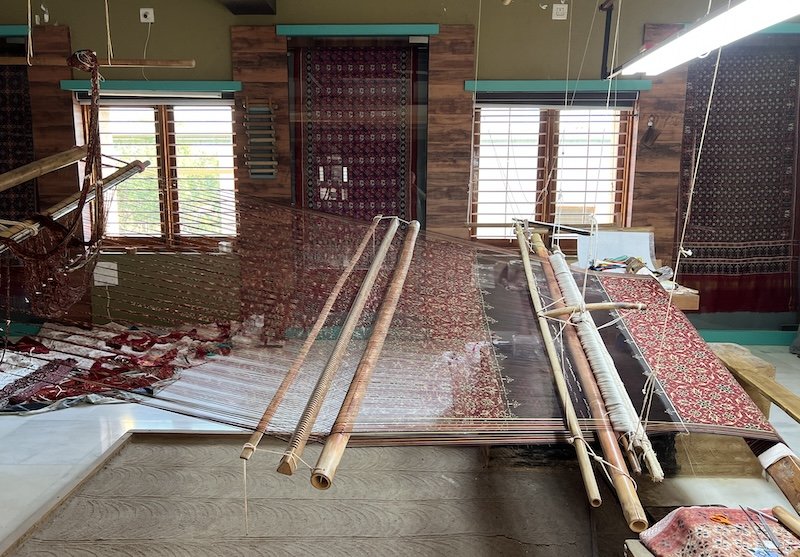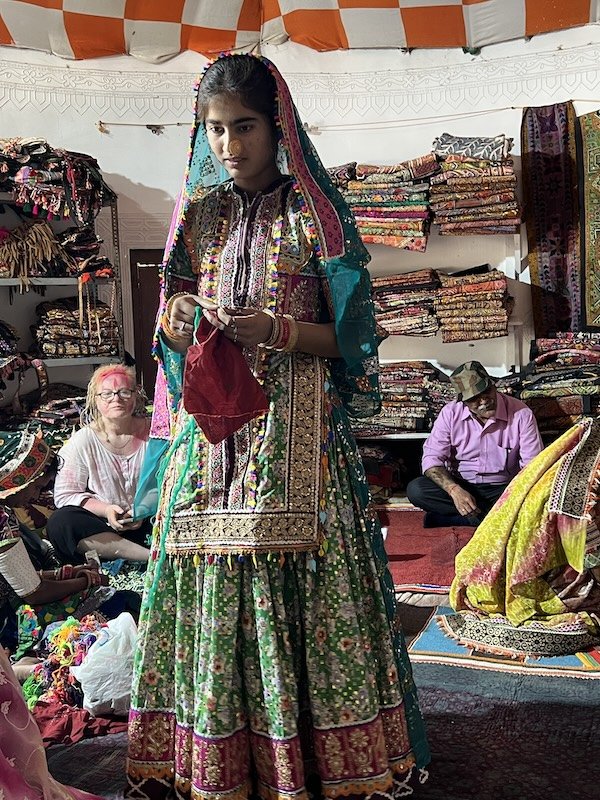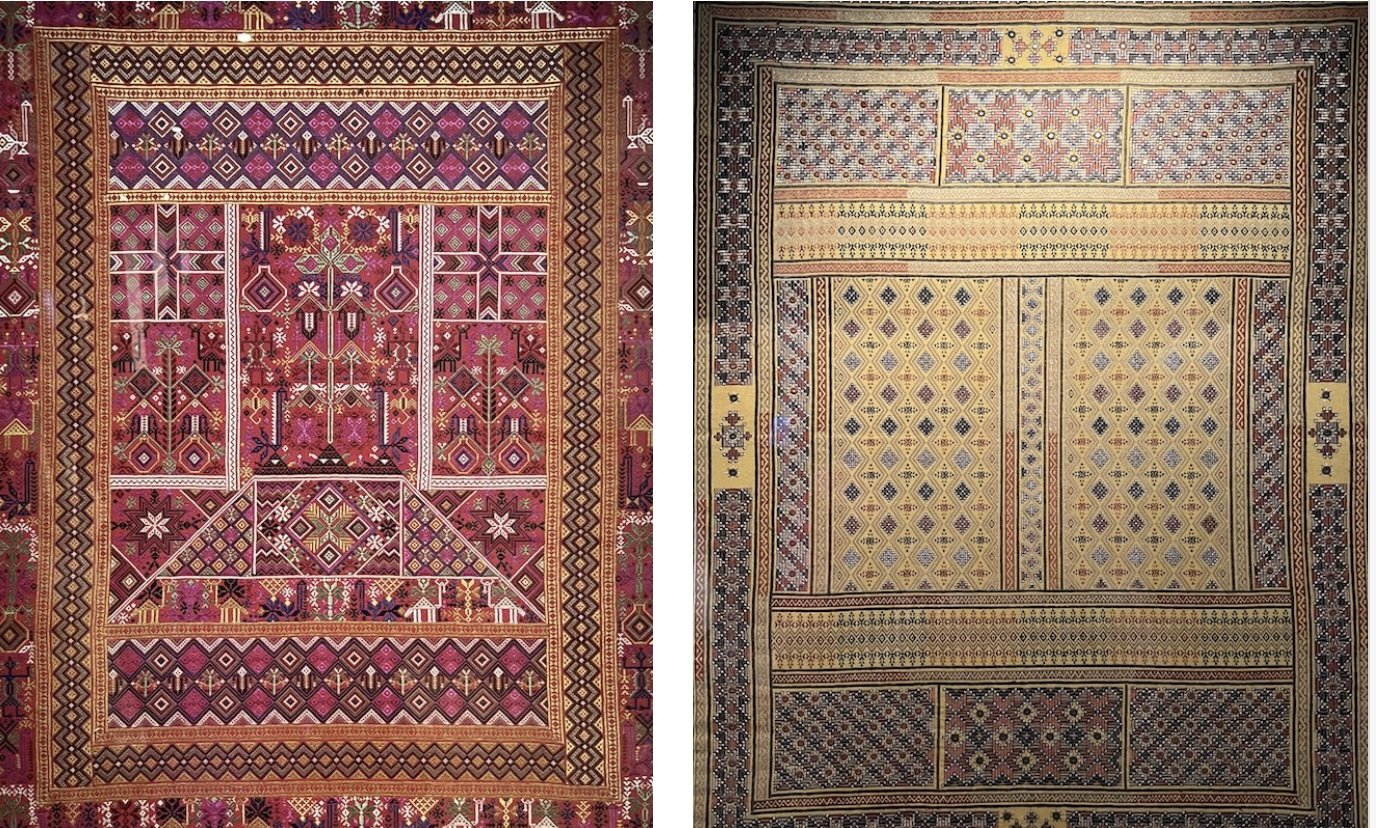India at Last!
I’ve been trying to get to India for at least ten years, but one life event or another has always kept me from following through on my plans. That is, until March of this year, when I went on a second textile tour with Behind the Scenes Adventures, along with a couple of my favorite textile traveling buddies from Houston.
Our tour was focused on the northwest region of India - New Delhi, Uttar Pradesh, Rajastan and Gujarat - and their deep textile traditions. We also visited numerous historic and architectural sites and had special experiences with outstanding local guides in each region along the way.
Our group of twelve, plus leaders and guides, started out in New Delhi, where we explored the city by multiple tuk tuks through the wild and crazy traffic. After taking in the aromas of the spice market we paid a visit to Humayun’s Tomb complex, a tantalizing precursor to the Taj Mahal.
Next we spent several hours at the outstanding National Handcrafts Museum, which is an extensive complex. We focused on just the two buildings that had the textile collection, but still didn’t have enough time to take everything in. The pieces that amazed me the most were two examples of contemporary ikat. They appeared at first to be printed or embroidered because the scale and detail was so fine, but on closer inspection the precision of the ikat dyeing became apparent.
Our next landing place was Agra, but we stopped along the way for a couple hours at the SOS Wildlife Center, an organization that has rescued hundreds of the sloth bears that are native to India from various abusive situations. They will never be able to be released into the wild again, but are well taken care of here.
Naturally, a trip to India wouldn’t be complete without a pilgrimage to the Taj Mahal. Like Machu Picchu or the pyramids in Egypt, the Taj Mahal is a familiar image to all of us, but nothing can prepare you for what it feels like to be in its presence.
The intricate carvings in the white marble of this pinnacle of Mughal architecture feels like complete perfection of form, balance and symmetry. Our local guide, Sunny enriched our experience with the background and history of the Taj, the gardens and the other buildings in the complex.
With my travel buddies Laura Viada and Tracy Kaestner, happy to be here!
Another amazing site in Agra was the Red Fort and some of the intricate marble inlay work in its interior.
We had an opportunity to see the process of how the marble inlay is created at Akbar International. We also were introduced to zar-dozi embroidery, which translates as “gold work” at a multi-generational workshop. Silk and metal threads are sewn onto a fabric base that is stretched over a frame and precious and semi-precious gems are often sewn on as well. We watched the men in the process of doing the embroidery and were invited to try a bit of it for ourselves.
Following our time in Agra we traveled by bus to the city of Jaipur, which is the capital city of the northwestern state of Rajastan. Jaipur is known as the Pink City because of the predominant use of the red and pink sandstone in its buildings. The Palace of Wind is a particularly impressive building that you see as you pass through the old section of the city.
During a walk through the interior courtyards of the Palace we saw multiple doorways, each beautifully carved and painted in a unique style.
Jaipur is a UNESCO World heritage city and also is is the home of two UNESCO World heritage sites. One is the Jantar Mantar, a collection of 19 large-scale astronomical instruments built in the 18th century. The other is the Amber Fort, which sits high on a hillside above a lake on the outskirts of Jaipur.
The palace inside the fort is a spectacular building that had been the home to Rajput Maharajas. Every surface, inside and out is intricately decorated with carving and painting, marble inlay and mirrors.
An area of textile design that I was particularly interested in exploring on this trip was the art of block printing. A visit to the Anokhi Mueum of Hand Printing was a brief, but tantalizing preivew of what we would be seeing and doing in workshops over the coming days.
We drove out to the the nearby town of Bagru, which is known for its natural dyeing and hand block printing on cotton fabrics. As we neared the workshop of Deepak Chippa we saw lengths of block printed cloth drying in the sun.
After we were given a demonstration on how to ink up the blocks and carefully set them onto the cloth so that they registered and matched up properly we were given a length of cotton cloth and our choice of blocks and ink colors to work with.
It was fascinating to not only see how the printers lined up their blocks but also to hear the rhythmic thumping as they pounded their hands on the blocks.
Click square icon on lower right to view video in full screen
The next step in our journey was to fly from Jaipur to Ahmedabad in the state of Gujarat, where we were met by our exceptional guide Nirav, who would be with us for the remainder of our trip.
We stopped for a couple hours at the Gandhi Ashram, which was one of his residences and from where he led his Dandi March that led to the Indian independence movement.
We visited two Jain temples, one outside of Ahmedabad and one that we saw on a morning walk that Nirav led us on through the back neighborhoods of the city. Both were embellished with intricate and elegant carvings.
One of the finest collections of Indian textiles in the world is at the Calico Museum in Ahmedabad. We were led through the museum by a watchful curator who had an incredible level of knowledge but didn’t allow as much time in each space as we would have liked. Not only is the museum so much more than the name implies, but the extensive mansion that it is housed in is impressive in its own right.
Nearly everyone in our group brought something home when we paid a visit to a family of women who have been keeping the art of painting on cloth alive for eight generations.
Perhaps the biggest surprise on this trip had nothing to do with textiles. Have you ever heard of stepwells? I hadn’t before coming on this trip and I think they are one of the most remarkable things that I’ve never even heard of before. Stepwells are a form of underground architecture that were used as a means for storing water from the 7th to the 19th centuries. They were spaced about every 20 kilometers along the Silk Road to provide water, shelter, and a meeting place for the caravanserais. A series of multiple levels of steps in an Escher-esque pattern lead down to the level of the water.
Many of the stepwells are barely noticeable from street level, but when you arrive at the edge of them it is somewhat akin to the experience of coming upon the Grand Canyon. As you walk down level by level you see the amazing intricate carvings all the way around on the walls. Many of them have been forgotten, have become overgrown or used as garbage pits, but there is now an effort to excavate and save them for posterity. Over 2600 stepwells have been mapped in India so far. We visited three of these driving from Ahmedabad to Patan, including the famous Rani-ki-Vav stepwell that goes down seven levels and has been named a UNESCO World Heritage site.
After leaving the stepwells we arrived in the town of Patan and visited the workshop and Ikat Museum of the Salvi family of double ikat weavers. In double ikat both the warp and weft threads are tightly bound and dyed before weaving.
Once the warp has been tied and dyed for each successive color it is attached to a Patola loom which has a horizontal slant from the left to the right. The design has been tied and dyed so precisely that when woven the weft aligns perfectly with the warp to create beautiful intricate saris that are truly fit for a queen.
The next day for a complete change of pace and scenery we piled into several jeeps and headed out into the bush for a wildlife safari in the area of the Little Rann of Kutch. Along some of the marshy stretches we saw flocks of flamingos and many other types of birds, The highlight, however, was seeing a herd of the shy onagers, or wild asses. These elegant animals have an appearance between that of a donkey and that of a horse.
A more ubiquitous sight along the roads, on the streets, on the sidewalks, was the cows and bulls. They have the right of way wherever they are and you just make way for them. Some of them have a decoration of some kind around their necks or their ears as a way of identifying who they belong to.
We spent a couple nights staying in a safari lodge on the outskirts of Kutch and enjoyed the peace and quiet away from the cities and the full moon at night over the nearby lake. During one of the days here we traveled out to an area of small Banni villages where people of different ethnicities live in round huts, dress in colorful traditional attire, and create exquisite embroideries in which they embed the tiny sheesha mirrors.
We spent a morning in one of these huts being taught by the women how to make the embroidery stitches to encase these mirrors on a piece of cloth. It’s harder than it looks to get the stitches as even as they do, but we all came away with a small sample and enjoyed being with these lovely women.
Our time there coincided with Holi, or the Festival of Colors that is very celebratory. The children have bags of naturally colored powder that they delight in throwing at people. We were forewarned to wear clothes that we didn’t mind getting dirty and joined in the fun, both letting the kids in the village cover us in powder and throwing it back at them.
That afternoon after taking a break and putting clean clothes on again we drove out to a nearby village to pay a visit to Ramji of Tana Bana handloom designs. Ramji weaves on a pit loom, sitting at ground level with the treadles in the pit. Ramji demonstrated his process of weaving on the loom with a fly shuttle, and invited us to give it a try ourselves. Afterwards he gave a demonstration of how to wrap a turban and we had an opportunity to buy his textiles.
The next day we drove through Bhuj and out to the Khatri community of Ajrakh block printing. As we neared the workshop of Dr. Ismail and Sufiyan Khatri we saw lengths of indigo-dyed fabric drying in the sun and saw a group of men standing in a large vat of water rinsing out fabric that had already been resisted and printed. We were invited into the workshop and Sufiyan explained the multi-step process that can take up to two weeks to complete and showed us a sample book with each step of the process.
It takes several blocks that go together as a set and are individually carved to apply the gum arabic resist to areas that you want to remain undyed and inks to apply to other areas where you want different colors.
We were each given a square of cloth and got to choose a set of blocks to work with. We did a speeded-up version that could be done in one day without all the steps of washing and drying in between each application. As we finished printing our squares we hung them to dry in the sun so that they could later be washed and dipped into an indigo dye vat.
In the same compound as the block printing workshop was the fabulous Shrujan Crafts Museum that is dedicated to the craftspeople of Kutch. The vast majority of the displays were devoted to the various embroidery styles and techniques that are used by the women in the area. We spent a couple hours in awe of the beauty and workmanship in the hundreds of examples on display.
We all found ourselves tempted by the beautiful pieces of embroidery in the museum gift shop, and after a little shopping we went back to the block printing workshop to pick up our dyed and finished samples.
One more class awaited us on our last day in Bhuj. This was at the workshop of another member of the Khatri family, Alimohamed Isha, who specializes in the bandini tie dyeing. He demonstrated how designs are drawn on large sheets of parchment paper and then pricked with holes. The paper is laid over the fabric that will be used and a thin wash of ink is applied to transfer the dots onto the fabric. We were each given a small piece of silk that had the dots as a guide and shown the process of how to tie tiny binding knots aound each of the dots. We all struggled over our pieces of fabric for a couple hours, but only got a small section finished. Our pieces were dipped into an indigo vat and hung out to dry. We were proclaimed “pretty good for beginners”.
After our workshop and a special Gujarati Thali lunch of many small dishes we visited the home and textile collection of the Wazer family. We were shown hundreds of examples of antique and vintage textiles from various regions of India. A museum of this collection is being planned, and many of the embroideries that we saw in the Shrujan Museum the day before came out of this collection.
That evening we went into the old town of Bhuj for a little exploration of the market area. Bhuj was leveled by an earthquake in 2001 so much of the city is new construction and not particularly attractive. Some of the original buildings are still standing, but are no longer structurally sound enough to enter. Our leader, Cynthia, led us into a small stall in the market where a mountain of vintage textiles awaited us. It was impossible to see everything, but some of us found a treasure to take home.
On our last day in India we flew from Ahmedabad to Mumbai and spent an afternoon in the market before a final farewell dinner and a night’s sleep before our flights home.
Did we really do all this in just two and a half weeks? And all this is just one corner of the country! Whether further travels in India are in my my future remains to be seen, but I am left with many images of the friendly people, the beautiful textiles and all the wonderful memories.














































